Patients with particular needs - PowerPoint PPT Presentation
1 / 10
Title:
Patients with particular needs
Description:
25% of the workforce born overseas, with 15% coming from non-English speaking countries ... Opportunities for emersion in a culture different from one's own ... – PowerPoint PPT presentation
Number of Views:28
Avg rating:3.0/5.0
Title: Patients with particular needs
1
Patients with particular needs
- Susan Gilbert Hunt
- Occupational Therapy Program Director
2
- The need for health workers to provide
culturally appropriate and responsive services
has emerged as important with the increasingly
diverse population and the increase in consumer
or client knowledge and expectation. User pay
health systems create higher demands and
expectations on health professionals to provide
client responsive services.
3
- When stressing the importance of managing
diversity the Government highlights the following
Australian demographics- - 43 of Australians born overseas or have at least
one parent born overseas indicating a possible
cultural preference and networks from their
origins, - over 200 languages spoken in Australia, and
- 25 of the workforce born overseas, with 15
coming from non-English speaking countries - (Commonwealth of Australia 2005, p 10)
4
- Such demographics focus on culture or diversity
as being related to origin of birth and language
used which in terms of appreciating the diversity
of health consumers is quite narrow. - A culturally competent/ safe health worker is
someone who is also able to effectively work with
all people regardless of language, age, gender,
sexual orientation, economic status, disability,
or lifestyle choices. - Thus a culturally competent health worker is
required to respond to the needs of people whose
culture is different from the dominant culture
and this is includes more than people from a
different country (Cross et al, 1989).
5
- We need to develop the ability to respond to
people in a culturally sensitive manner despite
whether or not there are any visual cues of
difference. In other words we need to develop an
openness that enables us to respond to the
unforeseen in others.
6
So what are the barriers?
- Lack of knowledge regarding different cultural
groups? - Language issues?
- OR
- Unacknowledged values and assumptions
7
What does this picture tell you?
- What do you know about them?
- What do they know about you?
- How might you both feel or respond?
8
- What are likely scenarios for you?
9
What does the literature tell us?
- Input on cultural diversity increases student
awareness of issues but there is a of lack of
evidence as to how it impacts on practice1 - Whilst cultural is usually defined in the broader
sense there is a tendency for education input to
focus on aspects related to language and
ethnicity2, 3 - Opportunities for emersion in a culture different
from ones own resulted in greater skills in
cultural competence4, 5, 6, - Educators needs to be culturally competent and
have skills in managing groups5, 7,8
10
Literature Review References
- Beach et al. (2005). Cultural competence a
systematic review of health care provider
educational interventions. Med Care, 43(4),
356-373. - Rosen et al. (2004). A new approach to developing
cross-cultural communication skills. Medical
Teacher, 26(2), 126-132. - Crossan et al. (2004). Evaluating the effect of
cultural competency training on medical student
attitudes. Family Medicine, 36(3), 199-203. - Ekelman et al. (2003). Developing cultural
competence in occupational therapy and physical
therapy education a field emersion approach.
Journal of Allied Health, 32(2), 131-137. - MacAvoy, S. Lippman, DT. (2001). Teaching
culturally competent care nursing student
experience rural Appalachia. Journal of
Transcultural Nursing, 12(3), 221-227. - Caffrey et al. (2005). Improving the cultural
competence of nursing students Results of
integrating cultural content in the curriculum
and an international immersion experience.
Journal of Nursing Education, 44(5), 234-240. - Froehlich, J. Nesbit, SG. (2004). The aware
communicator dialogues on diversity.
Occupational Therapy in Health Care, 18(1/2),
171-184. - Kleiman et al. (2004). Using an eclectic model to
educate students about cultural influences on
nurse-patient relationship. Nurse Education
Perspectives, 25(5), 249-253.































